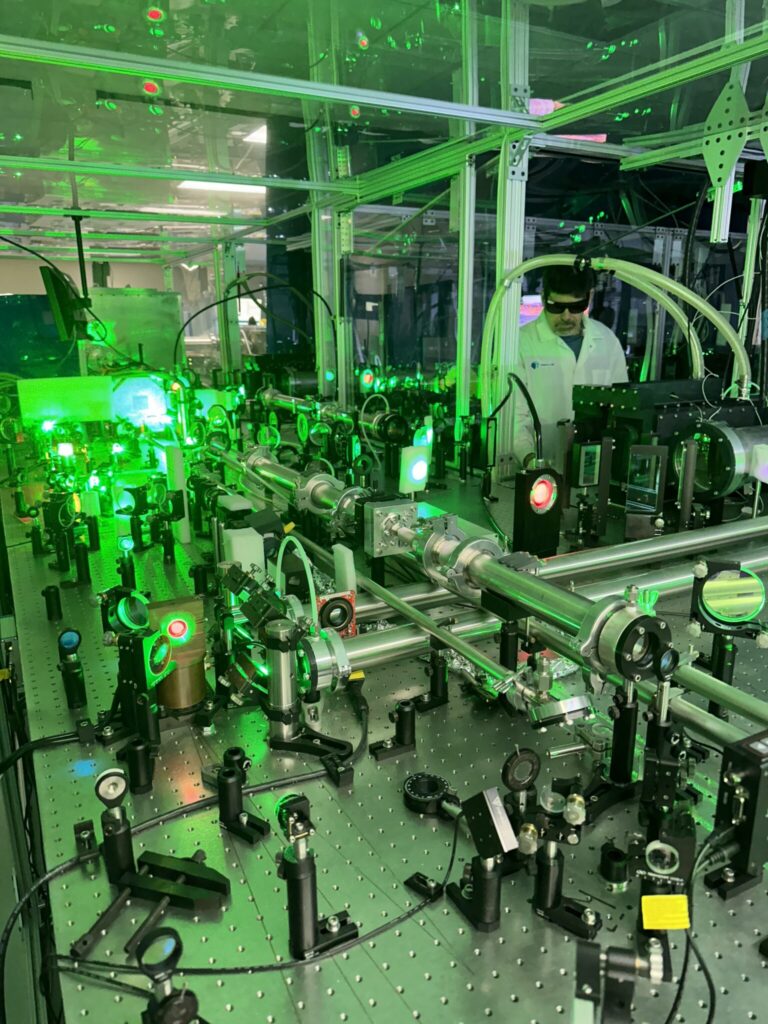
Colorado State University is a partner in a new project that leverages its world-class high-power laser and high energy physics capabilities to potentially revolutionize the imaging of very large objects.
Led by Lawrence Livermore National Laboratory, or LLNL, the multi-institutional collaboration is funded by the Defense Advanced Research Project Agency’s Muons for Science and Security Program. CSU’s participation includes scientists and engineers from the Departments of Electrical and Computer Engineering and Physics who will use ALEPH, one of the most powerful lasers in the world, developed at CSU.
The approach builds on previous breakthrough results in electron acceleration in a collaboration between the University of Maryland and CSU using ALEPH.
Using high-power lasers to accelerate muon imaging
Today we can see inside seemingly impossible places—nuclear reactors, volcanoes, tsunamis, hurricanes, and Egypt’s Great Pyramid of Giza—thanks to muon imaging. This technique uses naturally occurring subatomic particles called muons, which can penetrate far deeper than x-rays through material as thick and dense as 30-meter concrete walls.
But this process is also slow. Due to the low flux of naturally occurring muons, these images require exposure times on the order of months.
The new partnership seeks to change that by generating bright beams of these particles using high-power lasers. The collaboration also includes the University of Maryland, Extreme Light Infrastructure ERIC (ELI) at the ELI Beamlines Facility in the Czech Republic, Lockheed Martin, XUV Lasers – a CSU spinoff company led by University Distinguished Professor Carmen Menoni – and Lawrence Berkeley National Laboratory (LBNL). CSU is also participating in a separate LBNL-led project funded by the DARPA Muons for Science and Security Program.
The project aims to develop a technical design for a portable, laser-based muon emitter with orders of magnitude greater flux than naturally occurring muons that can be used in imaging across a wide range of applications. These include special nuclear materials detection, mining, and geophysics among other uses.
The ALEPH laser was developed under the direction of Jorge Rocca, University Distinguished Professor of Electrical and Computer Engineering and Physics, in collaboration with Yong Wang, Brad Luther, Reed Hollinger Shoujun Wang, and Carmen Menoni, with contributions of graduate and undergraduate students.
“This is an exciting project in the frontiers of science and technology that builds upon the results of many years of close collaborations between the participating institutions,” Rocca said.
The collaboration is led by Lawrence Livermore’s Brendan Reagan, who earned his bachelor’s and Ph.D. degrees from CSU.
“We have assembled a team of world leaders in the fields needed to meet the ambitious goals of DARPA’s Muon Program,” Reagan said. “This multi-faceted project combines high-power laser development, high-energy particle physics, plasma physics, advanced numerical simulations on high performance computing systems, and systems engineering and integration. This is an exciting program that highlights the science and technology capabilities of LLNL and the expertise of our partners.”
The muon detectors will be developed by CSU’s Physics Department High Energy Physics Group under the direction of Professor John Harton.
“This project is a grand challenge for particle physics detection,” said Harton. “The muon particles are outnumbered by huge factors by other particles, and we are using all the tools in the box to sift them out. This is particle physics with a practical application, and we are glad to be involved.”
Roadmap and key partners
The first phase of the four-year program will focus on proof-of-principle experiments to be conducted at CSU’s ALEPH laser facility to clearly demonstrate laser-produced muons. The second phase will seek to demonstrate high-energy muon production along with a design for a transportable muon source.
Initial experiments will be conducted using UMD-developed plasma waveguides at CSU‘s ALEPH high-rep-rated petawatt laser facility. Higher energy acceleration and muon generation experiments will be subsequently conducted at the ELI Beamlines laser facility in Europe.
Aspects of this initiative make use of the ALEPH laser facility funded by the U.S. Department of Energy Office of Fusion Energy Science through LaserNetUS and the Air Force Office of Scientific Research. Part of the initiative also builds on high-power laser development at Lawrence Livermore and XUV Lasers, which includes support from the DOE Office of Science’s Office of High Energy Physics and Accelerator Research and Development.
Other CSU personnel directly participating the project include Reed Hollinger, Shoujun Wang, Sina Zahedpour Anaraki, Jim King, Yong Wang, Vyacheslav Shlyaptsev, Ping Zhang, Bryan Sullivan, Gerardo Palma, Fernando Tomasel, David Warner, Kaixin Zhu, John Jabloski, Zack Rautio, Nikola Durand ,Tabor Horrigan, Kaid Pait, and Christian Norris.